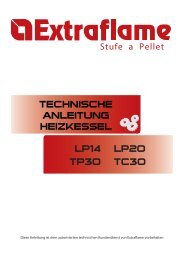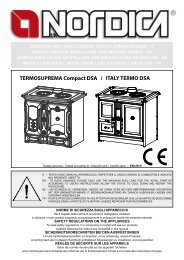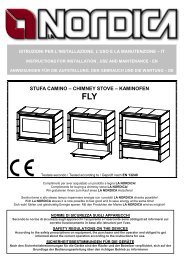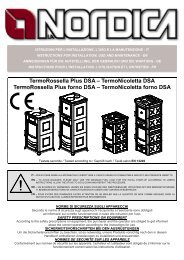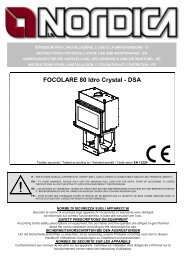TERMOSOVRANA - DSA - HJS-Internethandel
TERMOSOVRANA - DSA - HJS-Internethandel
TERMOSOVRANA - DSA - HJS-Internethandel
Create successful ePaper yourself
Turn your PDF publications into a flip-book with our unique Google optimized e-Paper software.
TermoSovrana <strong>DSA</strong><br />
appliance; to avoid this, it is necessary to intubate the appliance for its entire height. A section which is too small<br />
causes a reduction in draught.<br />
The flue must be suitably distanced from flammable or combustible material using suitable insulation or an<br />
air space.<br />
It is FORBIDDEN to pass system piping or air ducts inside the flue. It is also forbidden to create moveable or fixed<br />
openings on the flue itself, for the connection of further different appliances.<br />
IMPORTANT: refer to chapter 16.<br />
5.1. POSITION OF THE CHIMNEY POT<br />
The flue draught depends on the suitability of the chimney pot.<br />
It is therefore essential that, if built in a handcrafted way, the exit section is more than twice the internal section of the<br />
flue. As it must always go past the ridge of the roof, the chimney pot must ensure exhaust even in the presence of<br />
wind. (Picture 6).<br />
The chimney pot must meet the following requirements:<br />
• have an internal section equivalent to that of the chimney.<br />
• have a useful exit section of double the internal section of the flue.<br />
• be built so as to prevent rain, snow or any foreign body entering the flue.<br />
• be easy to inspect, for any maintenance and cleaning operations.<br />
(1) Industrial chimney pot<br />
with prefabricated<br />
components, allowing<br />
excellent flue gas<br />
disposal.<br />
(2) Handcrafted chimney<br />
pot. The correct exit section<br />
must be at least twice the<br />
internal section of the flue,<br />
ideally 2.5 times.<br />
(3) Chimney pot for<br />
steel flue with internal<br />
flue gas deflector cone.<br />
Picture 6<br />
50 cm<br />
(1) If there are flues which are side by side, one<br />
chimney pot must surpass the other by at least 50<br />
cm in order to avoid pressure transfers between the<br />
flues themselves.<br />
Picture 7<br />
2 m 10 m<br />
1<br />
m<br />
(1) The chimney pot must not have obstacles within 10 m such<br />
as walls, slopes or trees. If this is not the case, raise the pot by<br />
at least 1 m above the obstacle.<br />
The chimney pot must surpass the roof ridge by at least 1 m.<br />
Picture 8<br />
26 7094211 Rev.03 – EN



